 MAMA XI 36 (Eumeneia)
MAMA XI 36 (Eumeneia) 
Funerary bomos of Aur. Alexandros and family and Aur. Zotikos and family
- Type of monument:
- Funerary bomos.
- Location:
- Emircik (Eumeneia): behind the school.
- Description:
- Bomos of coarse-grained whitish marble, broken below; in pediment of front face, round boss; inscription A on front face (line 1 on upper moulding, remainder on shaft), inscription B on right face.
- Dimensions:
- Ht. 0.59+; W. 0.32 (upper moulding), 0.26 (shaft); Th. 0.32 (upper moulding), 0.27 (shaft); letters 0.022-0.025 (A line 1), 0.013-0.019 (A lines 2-22), 0.015-0.018 (B).
- Record:
- Squeeze; WMC notebook copy; photograph (1954/14).
- Publication:
- Calder 1955: 38; (BE 1956, 283; SEG 15, 811).
- Date:
- AD 246 (Year 231 of Sullan era, Month 2).
A
[ἔ]τους τλα´ μη(νὸς) β´
Αὐρ(ήλιος) · Ἀλέξανδρος
Σηίου φυ(λῆς) Ἀπολλων-
ί̣δος καὶ Αὐρ(ήλιος) · Ζηνω-
5νὶς ἡ γυνὴ αὐτοῦ κα-
τεσκεύασαν τὸ ἡρῷ-
ον ἑαυτοῖς καὶ τοῖς
τέκνοις αὐτῶν Ἀμμ-
ίᾳ καὶ Μεσσαλείνῃ καὶ
10 Ζηνωνίδι καὶ Ἀλε-
ξανδρείᾳ, ἣ ἂν ἄτε-
κ̣νος ἐξ αὐτῶν τελε[υ]-
[τ]ήσῃ· εἰ δέ τις ἕτερον ἐπ-
[ε]νένκῃ πτῶμα, ἔστα[ι]
15[α]ὐτῷ πρὸς τὸν Θε-
[ὸ]ν καὶ νῦν καὶ τῷ π-
[α]ντὶ αἰῶνι, καὶ μὴ τύ-
[χ]υτο τῆς τοῦ Θεοῦ
[ἐ]π̣ανγελίας· καὶ ὃς̣ [ἂν]
20[κ]ωλύσει αὐτῶν [τεθ]-
[ῆν]αί τινα, τῇ προ̣[κειμ]-
[έν]ῃ̣ αἱρέσι ἐ[νέχοιτο?]
- - - - - - - - - -
B
Αὐρ(ήλιος) Ζωτικὸς Γαί-
ου κατεσκεύασεν τὸ
ἡρῷον τὸ ἀπὸ βορέ̣-
ου ἑαυτῷ καὶ τῇ γυ-
5νεκὶ αὐτοῦ Αὐρ(ηλία) Κό-
μψῃ· μετὰ δὲ αὐτοὺ̣[ς]
κηδευθῆναι, οὐδε-
νὶ ἑτέρῳ ἔξον ἔ⟨σ⟩ται θ[εῖ]-
ναι ἰς αὐτό, εἰ μή τιν-
10α αὐτοὶ θέλουσιν̣
ἰς αὐτὸ κηδεῦσα̣[ί]
τινα μέχρι ζῶσιν· με-
τὰ δὲ ταῦτα εἴ τις ἕτε-
ρον ἐπιχειρήσει θεῖνα[ι]
15ἰς αὐτ⟨ό, ἔσται αὐτ⟩ῷ{ν} πρὸς τὸν Θ[ε]-
ὸν καὶ μὴ τύχυτο τ-
[ῆς]τοῦ Θεοῦ ἐπανγ-
[ελίας - - -]
[ἔ]τους τλα´ μη(νὸς) β´
Αὐρ(ήλιος) · Ἀλέξανδρος
Σηίου φυ(λῆς) Ἀπολλων-
ί̣δος καὶ Αὐρ(ήλιος) · Ζηνω-
5νὶς ἡ γυνὴ αὐτοῦ κα-
τεσκεύασαν τὸ ἡρῷ-
ον ἑαυτοῖς καὶ τοῖς
τέκνοις αὐτῶν Ἀμμ-
ίᾳ καὶ Μεσσαλείνῃ καὶ
10 Ζηνωνίδι καὶ Ἀλε-
ξανδρείᾳ, ἣ ἂν ἄτε-
κ̣νος ἐξ αὐτῶν τελε[υ]-
[τ]ήσῃ· εἰ δέ τις ἕτερον ἐπ-
[ε]νένκῃ πτῶμα, ἔστα[ι]
15[α]ὐτῷ πρὸς τὸν Θε-
[ὸ]ν καὶ νῦν καὶ τῷ π-
[α]ντὶ αἰῶνι, καὶ μὴ τύ-
[χ]υτο τῆς τοῦ Θεοῦ
[ἐ]π̣ανγελίας· καὶ ὃς̣ [ἂν]
20[κ]ωλύσει αὐτῶν [τεθ]-
[ῆν]αί τινα, τῇ προ̣[κειμ]-
[έν]ῃ̣ αἱρέσι ἐ[νέχοιτο?]
- - - - - - - - - -
B
Αὐρ(ήλιος) Ζωτικὸς Γαί-
ου κατεσκεύασεν τὸ
ἡρῷον τὸ ἀπὸ βορέ̣-
ου ἑαυτῷ καὶ τῇ γυ-
5νεκὶ αὐτοῦ Αὐρ(ηλία) Κό-
μψῃ· μετὰ δὲ αὐτοὺ̣[ς]
κηδευθῆναι, οὐδε-
νὶ ἑτέρῳ ἔξον ἔ⟨σ⟩ται θ[εῖ]-
ναι ἰς αὐτό, εἰ μή τιν-
10α αὐτοὶ θέλουσιν̣
ἰς αὐτὸ κηδεῦσα̣[ί]
τινα μέχρι ζῶσιν· με-
τὰ δὲ ταῦτα εἴ τις ἕτε-
ρον ἐπιχειρήσει θεῖνα[ι]
15ἰς αὐτ⟨ό, ἔσται αὐτ⟩ῷ{ν} πρὸς τὸν Θ[ε]-
ὸν καὶ μὴ τύχυτο τ-
[ῆς]
[ελίας - - -]
Line A-3: Τηίου C(alder).
Line B-15: ΙΣΑΥΤΩΝΠΡΟΣ lapis; ἔ̣σ⟨ται⟩ αὐτῷ πρὸς C.
(A) Year 331, Month 2. Aur. Alexandros, son of Seius, of the tribe Apollonis, and Aur. Zenonis his wife, constructed the tomb for themselves and for their children Ammia and Messalina and Zenonis and Alexandreia, whichever of them dies without children. If anyone inters another dead body, he will have to reckon with God, both now and for all time, and may he have no share in God’s promise; and whoever prevents any of them from being buried here, may he be subject to the afore-mentioned disposition.
(B) Aur. Zotikos constructed the tomb on the northern side for himself and his wife Aur. Kompse; after they have been interred, it shall not be permitted for anyone else to inter (anyone) in it, unless they themselves [Zotikos and Kompse] are willing during their lifetime that someone else should inter someone in it; but after that, if anyone tries to inter another, he shall have to reckon with God, and may he have no share in God’s promise.
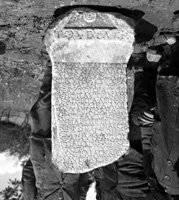
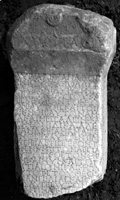
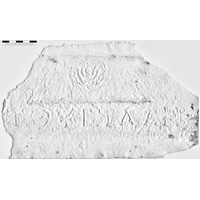
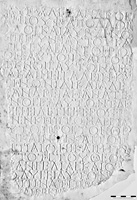
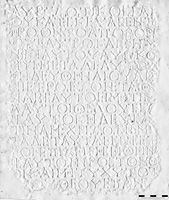



The inscriptions on Faces A and B were cut by the same mason. The inscription on Face A is dated precisely to Month 2 of Year 331 of the Sullan era (i.e. late AD 246), but no date is given on Face B; most probably the date applies to both faces of the stone. For the use of numbered months in the cities of southern Phrygia, see the commentary to MAMA XI 80 (1956/36: Sebaste); at Eumeneia, compare MAMA XI 38 (1954/17); MAMA XI 35 (Barnett 1954/2). The collaborative use of a single tombstone to mark two different family graves (apparently lying at right-angles to one another: B 3-4) is unusual, but cf. MAMA VI 325 (Akmoneia): τύνβοις γὰρ δύο τοῦτο τὸ σῆμα ἐπίκιται (two brothers and their families).
In line A 3, the correct reading is certainly Σηίου; for the name Seius at Eumeneia, see MAMA IV 341 (M. Seius Demagoras). For the name Κόμψη (B 5-6), cf. Robert, Hellenica X, 102 n.11. For the provision in lines A 11-13 (Alexandros’ daughters only to receive a place in the tomb if they die childless), see the commentary to MAMA XI 40 (1956/58).
This inscription provides us with the earliest dated example of the so-called ‘Eumeneian formula’ (A 14-16, B 15-16: ἔσται αὐτῷ πρὸς τὸν Θεὸν, ‘he will have to reckon with God’): see further MAMA XI 40 (1956/58), 41 (1954/21), 42 (1954/78=1957/167), all from Eumeneia; 17 (1956/93) (Apollonia); 181 (1955/24) (Synnada); 177 (1955/73: Prymnessos). This funerary curse-formula was widespread in southern Phrygia, and particularly on the territory of Eumeneia, in the late third and fourth centuries AD. The formula is generally regarded as Christian, but was demonstrably also used by Jews and pagans in the region: see especially Robert, Hellenica XI/XII, 399-413 (with earlier bibliography); Feissel 1980: 463-4; Trebilco 2002. Mitchell 1993: II 40 n.243 provides a list of datable third-century Christian inscriptions from Eumeneia and neighbouring cities.
The curse-formula in A 17-19 and B 16-18 (μὴ τύχυτο τῆς τοῦ Θεοῦ ἐπανγελίας, ‘may he have no share in God’s promise’) appears to be unique. The same sentiment is also attested in a recently-published Phrygian funerary inscription of uncertain provenance, perhaps from Eumeneia (SEG 55, 1431): ἔσται αὐτῷ πρὸς τὸν Θεὸν κα̣ὶ ΑΦ̣ΛΥΚ̣ΕΤΟΝ (ἀφαιρετὸν Chaniotis) αὐτοῦ τὸ μέρος τὸ ἐπουράνιον, ‘he shall have to reckon with God, and may his share in heaven be (?) taken away from him’. Robert compared the formula in our inscription with a Jewish tombstone from Beth She‘arim (Schwabe and Lifshitz 1974: no. 162; BE 1956, 340; Hellenica XI/XII, 408-9), stating that ‘whoever moves this [woman] shall be judged by Him who has promised to raise the dead to life’ (ὁ ἐπανγιλάμενος ζωποιῆσε τοὺς νεκρούς). An even closer parallel, as Robert later noted (BE 1958, 44), is provided by a Christian funerary inscription from Constantinople dated to AD 555 (Macridy and Ebersolt 1922: 356-62, no. 1, with Feissel 1994: 277-83), which declares that ‘I, the lowly one, have lived my short span of life; (now) I have received my share in God’s promise’ (κἀγὼ γὰρ ὁ ταπεινὸς ζῆσας τὸν ὀλίγον μου χρόνον τῆς ζωῆς, ἔτυχον τῆς ἐπαγγελίας τοῦ Θ(εο)ῦ).